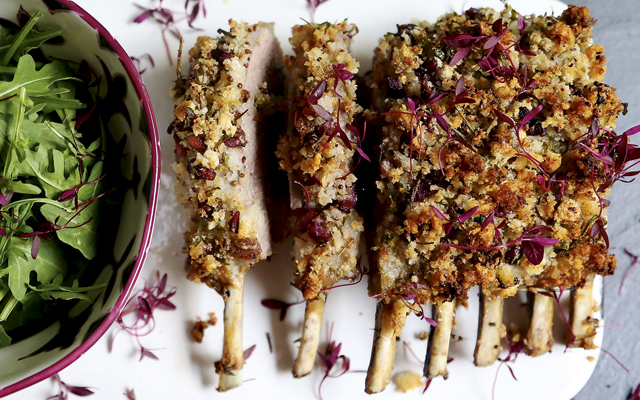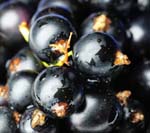How to grow currants
Currant affairs thrill Tom Coward.
Because we had such a mild spring and good pollination, the kitchen garden is simply dripping with fruit this year and we’re in the middle of harvesting a bumper crop of currants, which can be a little overwhelming in the kitchen. Summer pudding, tarts and jams are all to look forward to, but when time is precious, this fruit will freeze very well until a rainy day.
One of my favourite tricks is to pick directly into a bottle to make blackcurrant vodka, just as you would a sloe gin. This delicious drink is ready by Christmas, capturing the smell and taste of high summer like nothing else and is always the first medicine I reach for if a winter cold strikes. The exceptionally high levels of vitamin C in blackcurrants may well have medicinal value, but the comforting taste and sensation are what I feel really helps.
Red- and whitecurrants are both grown in a similar way and can crop quite successfully in the shade. Although they work well as bushes, they’re perfect as fans or cordons against a north wall, leaving sunnier locations for other crops.
Whitecurrants are a little sweeter than reds with beautiful, creamy, almost translucent fruit and as whitecurrants are almost impossible to buy in the shops, they have quite a special place in the garden.
White Versailles is one of the best-tasting varieties, which ripens with a slight golden hue; Blanka is also a good choice, with heavy crops.
Redcurrants are an important crop at Gravetye and, to spread the harvesting work, we like to grow early and late varieties. The French variety Junifer will crop in early July and Red Lake fruits a few weeks later in even more abundance.
Red- and whitecurrants fruit on old wood and so should be spur pruned back to one bud each winter. If they’re grown as a fan or cordon, then a further summer prune is necessary, reducing the season’s growth to five leaves.Blackcurrants, on the other hand, will fruit on younger wood and are best grown as bushes. Each winter, they should be pruned by removing one third of the older wood at the base.
Sign up for the Country Life Newsletter
Exquisite houses, the beauty of Nature, and how to get the most from your life, straight to your inbox.
If you forget which currant is which during the winter prune, only the blackcurrants will smell of their fruit when you scratch and sniff the stem. We’ve grown a blackcurrant called Ben Lomond at Gravetye for years, which always gives a brilliant and reliable crop. They are best grown in full sun so that the fruit gets as sweet as possible, but they still have quite a high acidity. Tartness is an important element of their flavour after cooking, but I’ve never been particularly fond of them raw.
This year, however, we’ve tried a new variety called Cassissima Noiroma, which was so sweet that it was delicious eaten direct from the plant. This new variety, bred by the Swiss nursery Lubera, has taken blackcurrants to a whole new level and I couldn’t recommend it enough. It’s supplied online at www.lubera.co.uk and is best ordered in autumn ready for planting time.
For the best-quality currants, it’s well worth watering in dry periods, as the fruit develops. We’ve laid some ‘leaky pipe’ along the base of our bushes under a thick layer of mulch. When the fruit is fully ripe, it can be very delicate and quite fiddly to pick. The easiest way to harvest is to wait until all the fruit is ripe on the truss, then snip the whole thing off with finger and thumbnail.
Netting the crop can be helpful, as the birds do love currants. In the past, we used to make a temporary cage out of posts and wires, covered in nylon netting. This definitely increased our yield and is certainly worth doing if you only have a few plants. We don’t bother with it any more, however, as putting it up is quite a big job and it also has the misfortune of looking quite ugly.
Without it, birds will take a portion of the fruit, but our bushes always seem to crop so well that there’s plenty for everyone. For me, currants are the quintessential summer fruit and even our fat black-birds deserve their share!

Rack of lamb with a redcurrant crust
Our kitchen garden cook rustles up rack of lamb with a redcurrant crust, redcurrant sauce and redcurrant and cherry crumble.

Greatest recipes ever: Blackcurrant cream
A wonderful English set blackcurrant cream recipe from Valentine Warner
-
 London is the place for me* (*the discerning property buyer)
London is the place for me* (*the discerning property buyer)With more buyers looking at London than anywhere else, is the 'race for space' finally over?
By Annabel Dixon
-
 Helicopters, fridges and Gianni Agnelli: How the humble Fiat Panda became a desirable design classic
Helicopters, fridges and Gianni Agnelli: How the humble Fiat Panda became a desirable design classicGianni Agnelli's Fiat Panda 4x4 Trekking is currently for sale with RM Sotheby's.
By Simon Mills